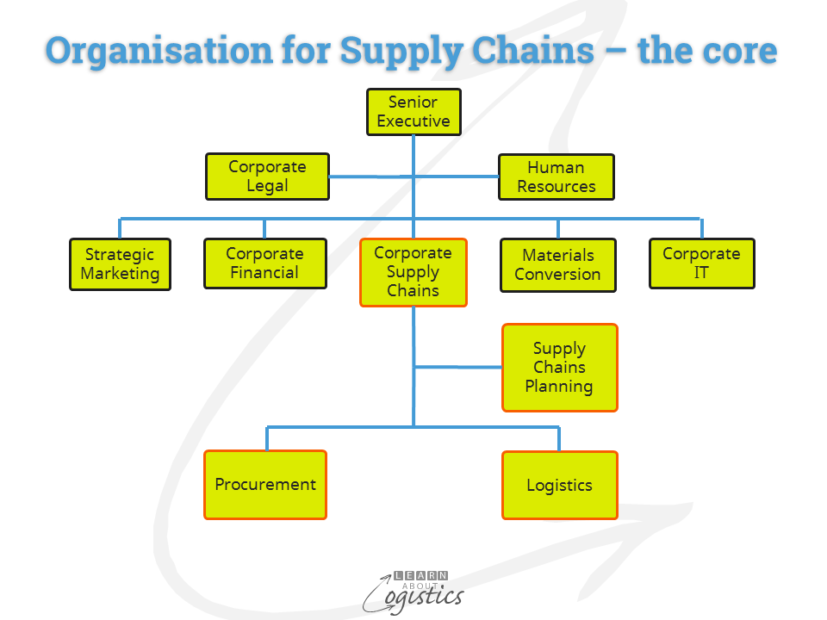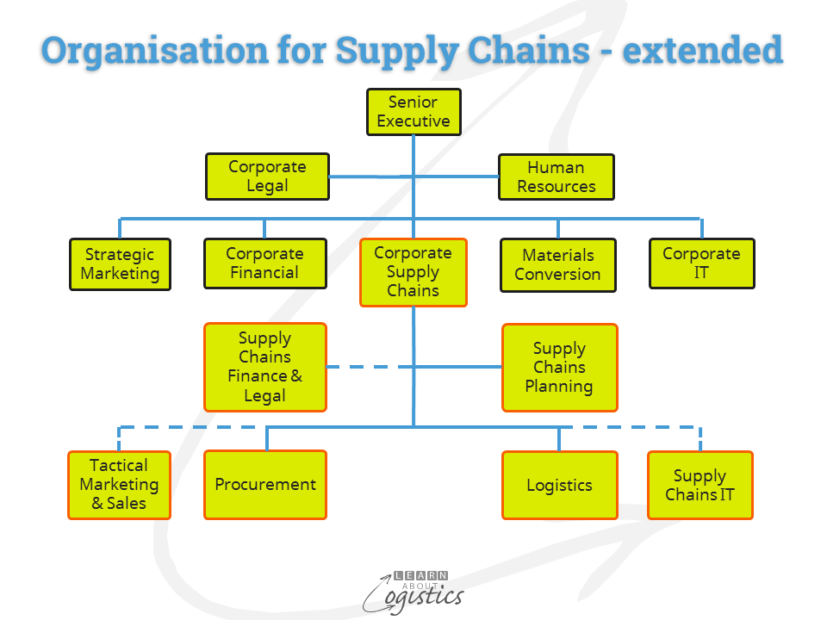Focus your supply chain organisation.
The overall objective of your supply chains is to ‘satisfy customer needs’. To achieve this requires ‘the time-related positioning of internal and external resources to provide availability of goods and services for customers at the lowest total cost’. This answers the question from senior management concerning ‘What will be gained from the supply chain organisation?’
To achieve the objective requires the supply chain organisation to manage the four flows of supply chains: items, money, transactions and information, ‘from plough to plate’. The supply chain organisation should therefore be focused on managing processes rather than being a function or department based structure. Allow the activities of teams to be combined to execute the supply chain processes and achieve the overall objective.
As the supply chain processes are concerned with the management of relationships to provide availability of products and services, a senior person reporting to the most senior executive should be responsible for these processes throughout your organisation.
Your supply network is unlikely to become ‘integrated’, as it comprises independent organisations with their own policy, objectives, customers and suppliers. The aim of your supply chain organisation should therefore be to understand the supply markets that your organisation relies on; then, through planning and systems have the ‘core’ supply chains responsive to your customers needs. How this is achieved will vary, depending on your organisation, its locations and cultural settings, the industry, products and markets.

The diagram illustrates the important factor of supply chains being at the same level as other senior executives; the visibility and resources associated with the supply chains position are recognised within the corporate hierarchy. Working with the senior management group, the role can influence the business strategy to take advantage of value creation opportunities in the supply chains. . The Corporate Supply Chains position is responsible for the overall performance of three core supply chains processes:
- Supply chains planning:
- facilitate strategy development for each supply chain process and consolidate the three strategies into the Supply Chains strategy
- sales and operations planning (S&OP) process
- master plan/schedule (Material Conversion (manufacturing, production or distribution packing) is responsible for scheduling materials and capacity to meet the Master Plan)
- supply chain analysis and metrics evaluation
- supply chain modelling and simulation projects
- Logistics
- develop the Logistics strategy
- movement and storage of materials and products, including reverse logistics
- schedule materials movements
- import and export of materials and products compliant with regulations
- settlement of accounts receivable and accounts payable; incorporated (with fraud checks) into the activities of product delivery and materials receipts
- Procurement
- develop the Procurement strategy
- develop and manage the procurement policy
- sourcing, purchasing and contracting (either centralised or decentralised; that is, located within strategic business units (SBU), subsidiaries and divisions)
- Procurement analysis and metrics evaluation
Extend the supply chains organisation
Three additional functions within the process flows can be incorporated into the supply chain organisation; this allows for a full function extended supply chain organisation The size and importance of these functions will depend on the type and size of a business and the business model.

Responsibilities of these functions would include:
- Supply chains finance and legal:
- measurement and management of working capital and cash flow
- approval of credit for customers and possible financing arrangements for selected suppliers
- identification and management of risk within the supply chains
- governance requirements for dealing with external parties
- compliance with international and domestic laws and regulations concerning supply chains
- measurement and management of working capital and cash flow
- Tactical marketing and sales
- short-term marketing and sales activities, based on the available supply of products
- retail promotions within fast moving consumer goods (FMCG) and consumer packaged goods (CPG) companies
- demand management process and input to the S&OP process
- short-term marketing and sales activities, based on the available supply of products
- Supply chains IT
- applications software and communications integration and interfacing that relate to the supply chains
- interfacing mobile computing and sensors with equipment for ‘in transit’ visibility (i.e. Internet of Things)
The organisation chart does not imply that the senior supply chains executive must take control of the multiple functions that contribute to the processes. As shown in the diagram, there can be a dotted line reporting line to supply chains and a solid reporting line to the equivalent corporate function i.e. matrix management. However, the additional functions can become an integral part of the supply chains organisation, in which case the dotted lines in the diagram become solid. The important factor is that the senior supply chains person must be responsible for the performance of the four flows through the supply chains (items, money, transactions and information).
The supply chains organisation structure discussed in this post has identified a core and extended structure for the effective management of the four flows through supply chains. While the core organisation structure should not generate too much argument, the extent to which additional functions are attached or incorporated could be the basis of much discussion in your organisation.

